International Relations: January 2023 UPSC Current Affairs | UPSC Mains: International Relations PDF Download
| Table of contents |

|
| The Indian Diaspora |

|
| India Sri Lanka Relations |

|
| India-Oman Strategic Dialogue |

|
| India-Egypt Relations |

|
| China’s Dam Diplomacy |

|
| Indus Water Treaty, 1960 |

|
| India-US Trade Policy Forum |

|
The Indian Diaspora
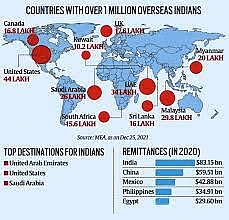
Why In News
- Recently, the Prime Minister of India inaugurated the 17th Pravasi Bharatiya Divas convention.
About Pravasi Bharatiya Divas (PBD)
- Origin:
- To mark this day, the tradition of celebrating Pravasi Bharatiya Divas (PBD) started in 2003.
- 1st PBD Convention was organized on 9 January 2003 to mark the contribution of the overseas Indian community to the development of India.
- Since 2015, under a revised format, PBD Convention has been organized once every 2 years (biennial).
- Significance:
- 9 January commemorates the return of Mahatma Gandhi from South Africa to India in 1915.
- It is celebrated grandly to strengthen the engagement of the Government of India with the overseas Indian community.
- Concerns with Celebrations:
- Low/semi-skilled and blue collar workers may not find a place or feel comfortable to participate in the said celebration as the general profile of participants is seen to be of very high level.
- The participation and involvement should be more broad-based, accommodating the vulnerable sections of the diaspora community too.
- Themes:
- 17th PBD- "Diaspora: Reliable Partners for India's Progress in Amrit Kaal".
- 16th PBD- "Contributing to Atma Nirbhar Bharat ''.
Indian Diaspora
- Meaning:
- The term diaspora traces its roots to the Greek diaspeiro, which means dispersion.
- Historical Background:
- The Indian diaspora has grown manifold since the first batch of Indians were taken to counties in the east pacific and the Caribbean islands under the ‘Girmitiya’ arrangement as indentured labourers.
- The 19th and early 20th centuries saw thousands of Indians shipped to those countries to work on plantations in British colonies, which were reeling under a labour crisis due to the abolition of slavery in 1833-34.
- 2023 marks the 150th year of the first such journey of Indians to Suriname.
- As part of the second wave of migration, nearly 20 lakh Indians went to Singapore and Malaysia to work in farms.
- The third and fourth wave saw professionals heading to western countries and workers going to the Gulf and west Asian countries in the wake of the oil boom.
- Numbers:
- As on December 31, 2021, there were 4.7 crore Indians living overseas.
- The number includes NRIs, PIOs, OCIs, and students. Excluding students, the number stands at 3.22 crore, including 1.87 crore PIOs and 1.35 crore NRIs.
- According to the World Migration Report, prepared by the International Organisation for Migration under the United Nations, India has the largest emigrant population in the world, making it the top origin country globally, followed by Mexico, Russian and China.
- Geographical spread:
- The geographical spread of the Indian diaspora is vast.
- The countries with over 10 lakh overseas Indians include United States of America (44 lakh), United Kingdom (17.6 lakh), United Arab Emirates (34 lakh), Sri Lanka (16 lakh), South Africa (15.6 lakh), Saudi Arabia (26 lakh), Myanmar (20 lakh), Malaysia (29.8 lakh), Kuwait (10.2 lakh) and Canada (16.8 lakh).
- Remittances:
- As per the latest World Bank Migration and Development Brief 2022, “For the first time a single country, India, is on track to receive more than $100 billion in yearly remittances.”
- The World Migration Report notes that India, China, Mexico, the Philippines and Egypt are (in descending order) among the top five remittance recipient countries, “although India and China were well above the rest”.
- Involvement in politics:
- The vocal political positions taken by a section of the Indian diaspora, particularly in the US and the UK, is a fairly recent phenomenon.
- For instance, the Hindu American Foundation, a Hindu advocacy group based in the US, was set up in 2003, the same year the Pravasi Bharatiya Convention was launched.
- Many prominent overseas Indians play an active role in organising global meetings.
Conclusion
- Indians living overseas are “brand ambassadors” of the country on foreign soil.
- Overseas Indians can project the truth about India to the world in a credible and effective manner and counter “propaganda”.
India Sri Lanka Relations
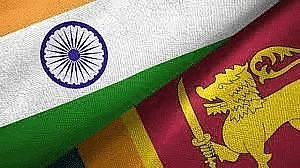
Why in News?
India sent financing assurances to the International Monetary Fund (IMF), becoming the first of Sri Lanka’s creditors to officially back the crisis-hit island nation’s debt restructuring programme.
- Details:
- The development comes ahead of External Affairs Minister S. Jaishankar’s visit to Colombo on January 19 and 20, and just as Sri Lankan leaders concluded talks with a visiting high-level delegation of the Communist Party of China.
- This takes Sri Lanka one step closer to getting a crucial $2.9-billion package from the IMF, made contingent on “receiving financing assurances from Sri Lanka’s official creditors and making a good faith effort to reach a collaborative agreement with private creditors.”
- China, Japan, and India are Sri Lanka’s three largest bilateral lenders.
- Background:
- India and Sri Lanka have a legacy of intellectual, cultural, religious and linguistic interaction and the relationship between the two countries is more than 2500 years old.
- The nearly three-decade-long armed conflict between Sri Lankan forces and the LTTE came to an end in May 2009. During the course of the conflict, India supported the right of the Government of Sri Lanka to act against terrorist forces.
- At the same time, it conveyed its deep concern at the plight of the civilian population, emphasizing that their rights and welfare should not get enmeshed in hostilities against the LTTE.
- Sri Lanka is India’s closest maritime neighbour and is strategically located in the Indian Ocean and Bay of Bengal. As per its ‘Neighbourhood-First Policy’ and the ‘SAGAR (Security and Growth for All in the Region) Doctrine’, India attaches great importance to Sri Lanka “to keep the Indian Ocean region peaceful and secure”.
- 70% of Indian cargo comes through the Colombo port, which is the largest trans-shipment port of South Asia.
- Political Relations:
- Historically, Sri Lanka was part of British India and since independence both countries had cordial relations.
- Unpleasantness in bilateral relations raised in 1983, when the Anti-Tamil violence in Sri Lanka dragged India into Tamil-Sinhalese Conflicts.
- With an objective of improving ties, Indo-Sri Lanka Peace Accord or Rajiv Gandhi-Jayewardene Accord was signed in 1987, which proposed a political solution to ongoing ethnic conflict by establishing a provincial council system and devolution of power to the nine provinces in Sri Lanka.( Popularly known as 13th Amendment to the Sri Lankan Constitution)
- India also deployed Indian Peace Keeping Force (IPKF) in Sri Lanka under Operation Pawan. After two year of military engagement IPKF was withdrawn as it failed to curb the Liberation Tigers of Tamil Eelam (LTTE) separatist movement.
- Commercial Relations:
- The entry into force of the India-Sri Lanka Free Trade Agreement (ISFTA) in 2000 contributed significantly towards the expansion of trade between the two countries.
- Economic ties between the two nations also include a flourishing development partnership that encompasses areas such as infrastructure, connectivity, transportation, housing, health, livelihood and rehabilitation, education, and industrial development.
- India has traditionally been among Sri Lanka’s largest trade partners and Sri Lanka remains among the largest trade partners of India in the SAARC.
- In 2020, India was Sri Lanka’s 2nd largest trading partner with bilateral merchandise trade amounting to about USD $ 3.6 billion.
- Sri Lankan exports to India have increased substantially since 2000 when the India-Sri Lanka Free Trade Agreement (ISLFTA) came into force and more than 60% of Sri Lanka’s total exports to India over the past few years have used the ISFTA benefits.
- Development Cooperation:
- Sri Lanka is one of India’s major development partners and this partnership has been an important pillar of bilateral ties between the two countries over the years.
- With grants alone amounting to around USD 570 million, the overall commitment by GOI is to the tune of more than USD 3.5 billion.
- Indian Housing Project, commitment to build 50,000 houses for the war affected as well as the estate workers in the plantation areas
- India continues to assist in a large number of High Impact Community Development Projects in areas of education, ambulance services all over the island, small and medium enterprise development and training.
- Defence and security Cooperation:
- Since 2012, India participates in Indo-Sri Lankan Defence Dialogue, this platform helps to review the security and defence cooperation issues between the two countries.
- To ensure maritime security India-Sri Lanka conduct ‘SLINEX’ a joint naval exercise, India, Sri Lanka and Maldives conduct “DOSTI” a trilateral naval exercise and India and Sri Lanka hold annual joint military drill 'Mitra Shakti’ to boost counter-terror cooperation
- Cultural relations:
- In contemporary times, the Cultural Cooperation Agreement signed by the Government of India and the Government of Sri Lanka on 29 November 1977 at New Delhi forms the basis for periodic Cultural Exchange Programmes between the two countries.
- Buddhism is one of the strongest pillars connecting the two nations and civilizations from the time when the Great Indian Emperor Ashoka sent his children Arhat Mahinda and Theri Sangamitta to spread the teachings of Lord Buddha at the request of King Devanampiya Tissa of Sri Lanka.
- Government of India formally launched the e-Tourist Visa (eTV) scheme for Sri Lankan tourists.
- India is the top source for tourist influx into Sri Lanka with over 4 lakh Indian tourists travelled to Sri Lanka in 2018.
- The Swami Vivekananda Cultural Centre (SVCC), the cultural arm of the High Commission of India, Colombo, has been playing a key role in strengthening these ties and promoting people-to-people contacts between India and Sri Lanka since its inception in 1998.
- Human resource development:
- Under the Indian Technical and Economic Cooperation Scheme and the Colombo Plan, India offers short and medium term training courses in technical and professional disciplines.
- Indian Community:
- The People of Indian Origin (PIOs) comprise Sindhis, Borahs, Gujaratis, Memons, Parsis, Malayalis and Telugu speaking persons who have settled down in Sri Lanka (most of them after partition) and are engaged in various business ventures. According to Government census figures (2011), the population of IOTs is about 1.6 million.
India-Oman Strategic Dialogue
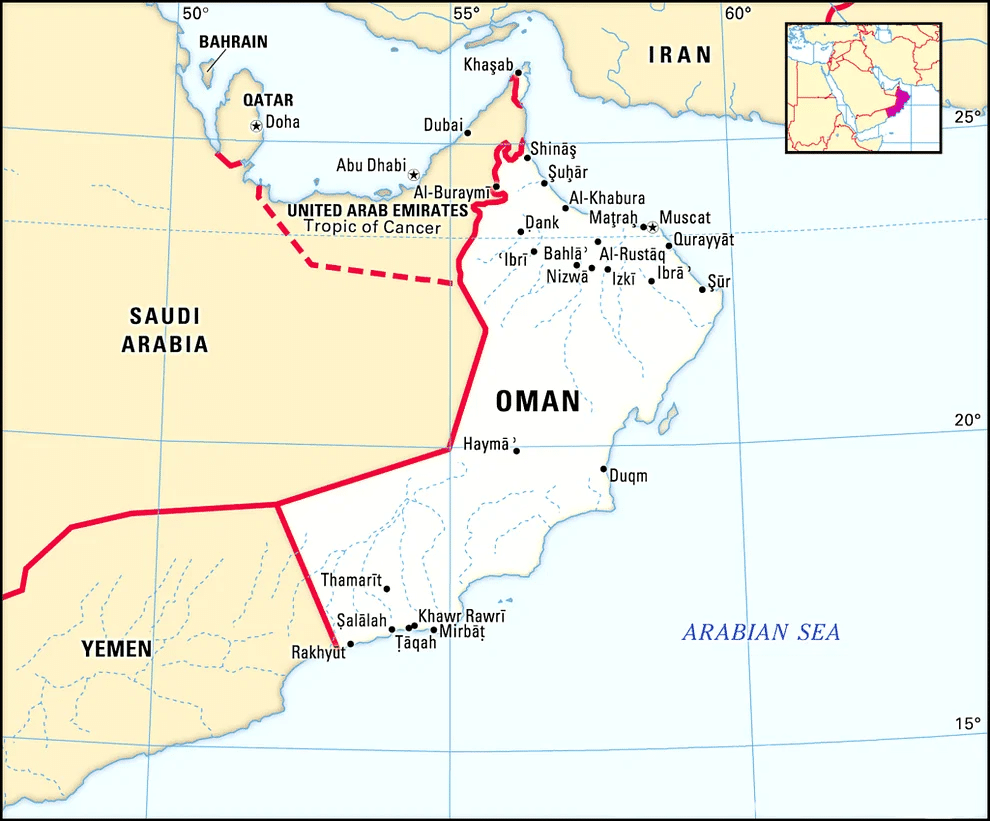
Why in News?
Recently, the 8th India-Oman strategic dialogue was held in India, where both countries have underlined the need to work collectively to fight the challenge of terrorism, terrorist propaganda, abuse of cyberspace and misuse of new and emerging technologies.
- They agreed to hold the next round of the strategic dialogue in Oman in 2024.
What are the Highlights of the Dialogue?
- Both sides highlighted the high priority accorded by the leadership of both countries to further enhance their strategic ties based on trust and mutual respect.
- Discussions were held on a wide range of issues of mutual interest, including bilateral strategic and security cooperation, defence and regional security.
- Both sides reiterated the importance of preserving Maritime Safety and Security in the region.
- Both sides reiterated the importance of the strategic dialogue as an important mechanism of bilateral cooperation between India and Oman.
What are the Key Points of India-Oman Relationship?
- Background:
- The two countries across the Arabian Sea are linked by geography, history and culture and enjoy warm and cordial relations, which are attributed to historical maritime trade linkages.
- The Sultanate of Oman is a strategic partner of India in the Gulf and an important interlocutor at the Gulf Cooperation Council (GCC), Arab League and Indian Ocean Rim Association (IORA) fora.
- Gandhi Peace Prize 2019 was conferred on Late HM Sultan Qaboos in recognition of his leadership in strengthening the ties between India & Oman and his efforts to promote peace in the Gulf region.
Defence Relations:
- Joint Military Cooperation Committee (JMCC):
- The JMCC is the highest forum of engagement between India and Oman in the field of defence.
- The JMCC is expected to meet annually, but could not be organised since 2018 when the meeting of the 9th JMCC was held in Oman.
- Military Exercises:
- Army exercise: Al Najah
- Air Force exercise: Eastern Bridge
- Naval Exercise: Naseem Al Bahr
- Economic & Commercial Relations:
- Institutional mechanisms like Joint Commission Meeting (JCM) and Joint Business Council (JBC) oversee economic cooperation between India and Oman.
- India is among Oman’s top trading partners.
- India is the 2nd largest market for Oman’s crude oil exports for the year 2022 after China.
- India is also the 4th largest market for Oman’s non-oil exports for the year 2022 after UAE, US and Saudi Arabia and 2nd largest source of its import after UAE.
- Indian companies have invested in Oman in sectors like iron and steel, cement, fertilisers, textile etc.
- India-Oman Joint Investment Fund (OIJIF), a JV between State Bank of India and State General Reserve Fund (SGRF) of Oman, a special purpose vehicle to invest in India, has been operational.
- Indian Community in Oman:
- There are about 6.2 lakh Indians in Oman, of which about 4.8 lakh are workers and professionals. There are Indian families living in Oman for more than 150-200 years.
What is Oman’s Strategic Significance for India?
- Oman is at the gateway of Strait of Hormuz through which India imports one-fifth of its oil imports.
- Defence cooperation has emerged as a key pillar for the robust India-Oman strategic partnership. Defence exchanges are guided by a Framework MOU which was recently renewed in 2021.
- Oman is the only country in the Gulf region with which all three services of the Indian armed forces conduct regular bilateral exercises and staff talks, enabling close cooperation and trust at the professional level.
- Oman also actively participates in the Indian Ocean Naval Symposium (IONS).
- In a strategic move to expand its footprint in the Indian Ocean region, India has secured access to the key Port of Duqm in Oman for military use and logistical support. This is part of India’s maritime strategy to counter Chinese influence and activities in the region.
- The Port of Duqm is situated on the southeastern seaboard of Oman, overlooking the Arabian Sea and the Indian Ocean.
- It is strategically located, in close proximity to the Chabahar port in Iran. With the Assumption Island being developed in Seychelles and Agalega in Mauritius, Duqm fits into India’s proactive maritime security roadmap.
Way Forward
- India does not have enough energy resources to serve its current or future energy requirements. The rapidly growing energy demand has contributed to the need for long term energy partnerships with countries like Oman.
- Oman’s Duqm Port is situated in the middle of international shipping lanes connecting East with West Asia.
- India needs to engage with Oman and take initiatives to utilise opportunities arising out of the Duqm Port industrial city.
- India should also work closely with Oman to enhance strategic depth in the region and add heft to its Indo-Pacific vision in the Western and Southern Part of Indian Ocean.
India-Egypt Relations
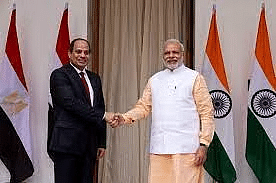
Why In News
India has invited Egypt as a special guest for the G-20 summit which shows our age-old relationship.
- The President of Egypt, Abdel Fattah el-Sisi, was the chief guest at the 74th Republic Day parade.
India-Egypt relations
- Historical: India and Egypt, two of the world’s oldest civilizations, have enjoyed a history of close contact from ancient times.
- Even prior to the Common Era, Ashoka’s edicts refer to his relations with Egypt under Ptolemy II.
- In modern times, Mahatma Gandhi and the Egyptian revolutionary Saad Zaghloul shared a common goal on independence from British colonial rule, and the two nations made a joint announcement of the establishment of diplomatic relations at the ambassadorial level three days after India became free.
- The two countries are celebrating the 75th anniversary of establishing diplomatic ties.
- A Friendship Treaty was signed between Prime Minister Jawaharlal Nehru and President Gamal Abdel Nasser in 1955.
- The Non-Aligned Movement was a natural concomitant of this relationship.
- Relationship since 2014: The year 2015 has seen more intense political cooperation between the two countries with regular interactions at the leadership and Ministerial levels.
- PM Shri Narendra Modi met President Sisi on the sidelines of UNGA, New York in September 2015.
- Their talks focussed on counter-terrorism, deepening economic engagement, and regional issues.
- The ties have been on an upswing in the recent past and both delegations supported reform of the UN Security Council, where Egypt was a non-permanent member during 2016-17 and India had a similar stint during 2021-22.
- Latest Developments
- India and Egypt signed five MoUs covering culture, cooperation on youth matters, cyber security, information and technology (IT) and public broadcasting.
- They reaffirmed their commitment to multilateralism, the principles of the United Nations Charter, international law, the founding values of the Non-Aligned Movement, and respect for the sovereignty and territorial integrity of all states.
- They agreed to “initiate new engagements to intensify military-to-military engagements” and planned more joint exercises between the armed forces of the two countries.
- They agreed to fight terrorism in all forms, “including cross-border terrorism” and intensify consultation between their respective National Security Councils.
- They have expressed exploring the possibility of land allocation to Indian Industries at the Suez Canal Economic Zone.
- The Suez Canal connects the Mediterranean Sea with the Red Sea.
- It is one of the world's biggest trade routes. As of now, the trade route is essential to keep alive around 12 percent of the global trade that passes through it each day.
- Significance
- Egypt, the most populous country in West Asia, occupies a crucial geo-strategic location — 12% of global trade passes through the Suez Canal — and is a key player in the region.
- It is a major market for India and can act as a gateway to both Europe and Africa.
- It also has bilateral trade pacts with important West Asian and African nations.
- Egypt’s relationship with India was also helped by its display of pragmatism especially in the backdrop of the Nupur Sharma controversy of 2022 when Cairo maintained silence while certain Gulf countries were vocal in India’s criticism.
- The joint cooperation will help eliminate violence because the spread of violence, terrorism, and extremist ideology represents a serious threat not only to the two countries but also to all countries around the world.
- Concerns
- India and Egypt are “worried about the spread of terrorism happening around the world” and they are “unanimous” that terrorism is the “most serious security threat” to humanity.
- Misuse of cyberspace to spread extremist ideologies and radicalisation is a growing menace.
- Egypt’s economy has been in shambles over the past few years. It was battered by the collapse of tourism during the pandemic, and the Russia-Ukraine war has impacted its supply of food — almost 80% of Egypt’s grain came from these two countries — and hit its foreign exchange reserves.
- Despite restrictions on the export of wheat, India had last year allowed shipments of 61,500 metric tonnes to Egypt.
- But the country needs more.
- China’s bilateral trade with Egypt is currently at $15 billion, double that of India’s $7.26 billion in 2021-22.
- Sisi has been wooing Chinese investments, and has travelled to China as many as seven times in the last eight years
Conclusion and Way Forward
- Concerted action is necessary to end cross-border terrorism” and they will have to together alert the international community.
- More than six decades ago, the two countries founded the NAM. They now have an opportunity to forge a new path ahead, not just for their strategic and economic interests, but as the voice of the Global South.
China’s Dam Diplomacy

Why in News?
China is constructing a new dam on the Mabja Zangbo river in Tibet, close to the tri-junction which is a matter of concern for both India and Nepal.
- The new dam is located around 16 km north of the tri-junction and is opposite the Kalapani area of Uttarakhand.
- The Mabja Zangbo river originates in Nagari county of Tibet and flows through Nepal into the Ghaghara River before joining the Ganga in India.
About
- China's upstream actions like dams (on Brahmaputra, Indus, tributaries of the Ganga), diversion of water, hydropolitics, and power asymmetry poses a security threat to India and water scarcity downstream.
- There is no legally binding international treaty on water sharing between India and China.
- Under CPEC, China plans to build two mega-dams on the Indus, named Bunji Dam and Bhasha Dam.
- In 2021, China announced that it would construct a massive dam on the lower reaches of Yarlung Zangbo (also known as Brahmaputra) to generate up to 70 GW of power, three times that of the country’s Three Gorges dam, which is the world’s largest hydropower plant in terms of installed capacity.
Impact of Building Dams on India
- Used as a tool in Hydropolitics: China is a critical player in the hydro-politics of the region. Its hydrological position is one of complete upper riparian supremacy giving it enormous latitude in shaping larger political equations with its riparian neighbours.
- India is an upper, middle, and lower riparian. India’s middle riparian position increases its dependency (water insecurity) on the headwaters of the rivers such as the Indus, Sutlej, and Brahmaputra which originate in the Tibetan plateau.
- China wants to maintain continuous pressure on India be it all along the Himalayan range or the Indian Ocean region through building dams alongside border areas.
- India and its Neighbourhood: China was one of the three countries that did not approve of the 1997 UN Convention on the Law of the Non-Navigational Uses of International Waterways.
- China has built eleven mega-dams on the Mekong River, causing water levels there to fluctuate widely without prior notice in Myanmar, Laos, Thailand, Cambodia, and Vietnam.
- Impact on earlier signed Treaty: Treaties have been signed to provide definite amount of water to lower riparian states like the 1960 Indus Water Treaty with Pakistan and the 1996 Ganga Treaty with Bangladesh.
- Military threat to India from Border Infrastructure: China’s rapid build-up of infrastructure along the Line of Actual Control (LAC) with India is alarming and adds to overall destabilising and corrosive behaviour along the entire India-China border.
- The satellite images of the dam on Mabja Zangbo river shows the formation of an embankment type dam with a reservoir leading to a possibility of military establishment by China near the tri-junction already witnessed from Yarlung Zangbo dam.
- From the multiple intrusions into Indian territory in eastern Ladakh, China has assiduously built and consolidated its military positions and border infrastructure along LAC as well upgraded its air bases facing India. E.g., China construction of a bridge across Pangong Tso in Khurnak Fort Area.
- Impact on people lives Downstream: China projects alongside Brahmaputra will impact lower riparian states local economy and ecology due to future plans of water diversion and dam projects.
- China’s construction of hydroelectricity dams in ecologically and seismically active areas shows reassertion of its aggressive ‘supply-side hydraulic’ approach of increasing storage capacity by building dams and reservoirs.
- These steps can impact food and water security needs of people living in low riparian regions as well increase disaster risk.
- Water Resources of North-East: Even running of the river hydroelectric dams can reduce water flow downstream, especially during the dry season.
- India is also worried about the release of water during the monsoons, when north-eastern states such as Assam experience ?oods.
- Several species of ?ora and fauna are endemic to the North-East part of India and some of them are critically endangered. The ecosystem in the Himalayan region is already on the decline.
- Seismological Impact: The Himalayan region is vulnerable to earthquakes and other seismic activities. The sheer size of the infrastructure projects undertaken there poses a signi?cant threat to the populations living downstream.
- Chins building hydrological projects along geographical fault lines. E.g., Projects on Yarlung Zangbo river are along the collision boundary of Indian plate and Eurasian plate.
- The glaciers have been retreating due to climate change. Deforestation, soil erosion and landslides are some of the other issues.
- Water as a Weapon during Standoff: Being an upstream area, China has a clear advantage in building dams and other infrastructure to store or divert the ?ow of the river system.
- There is the potential to signi?cantly change the ?ow rate during times of stando? between the countries.
- During the 2017 Doklam border stando? between India and China, China stopped communication of water ?ow levels from its dams.
Way Forward
- By terming water resources in Tibet as a ‘commons’, India can draw international attention. China should be pressurized to reconsider signing of 1996 UN Convention on Non- Navigation Use of Water which requires watercourse states to cooperate on the equitable and reasonable use and management of international watercourses.
- India needs to strengthen agreements with China that require the latter to share hydrological data of the river during monsoon season between May and October to alert downstream areas in the event of ?oods.
- India to articulate its middle riparian position, first to change the perception in the neighbourhood that India is a ‘water hegemon’.
- India to draw China into the South Asian water equation through a multi-lateral basin approach, thereby sensitising China to downstream concerns and upstream responsibilities.
- Water Treaty on lines of Indus and Ganga Treaty need to be devised with China for rivers originating from Tibet region.
- India should initiate a lower riparian coalition, stretching from the Ganga Brahmaputra Meghna basin to the Mekong, in order to draw China into a water dialogue.
- Tibet has an essential influence over Asia, providing sustenance to some of the world’s most productive agricultural zones, so it is the collective responsibility of all riparian states to preserve the ecology of this region.
Indus Water Treaty, 1960
Why in News?
- India has issued a notice to Pakistan for modification to the treaty as per Article XII (3) of the Indus Water Treaty (IWT) due to Pakistan's refusal to implement the treaty.
About
- Under the notice, India has called on Pakistan to enter into intergovernmental negotiations within 90 days.
- According to India, the treaty requires that disputes be resolved through bilateral negotiations and consultations between the two countries, rather than through international arbitration.
What is the Indus Water Treaty?
- In 1960, India and Pakistan signed the Indus Waters Treaty with the World Bank as a signatory of the pact.
- Under the treaty, India got control over the three eastern rivers Beas, Ravi, and Sutlej while Pakistan got control of the western rivers Indus, Jhelum, and the Chenab.
- According to the treaty, India has the right to generate hydroelectricity through the run-of-the-river (RoR) projects on the western rivers which, are subject to specific criteria for design and operation.
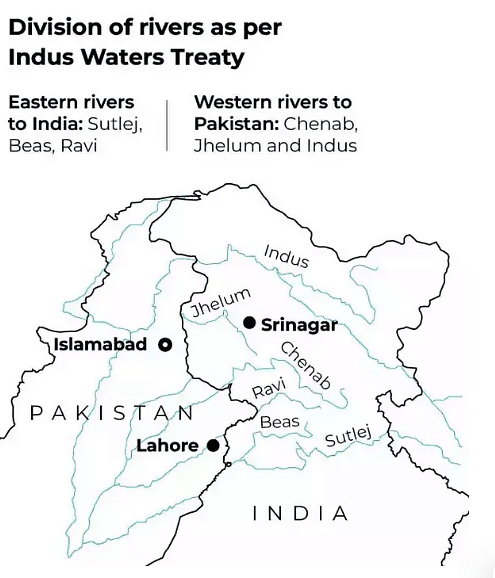
Dispute Resolution Process
- According to Article IX of the treaty that deals with the “Settlement of Differences and Disputes”, there are three possible steps to decide on objections raised by either side.
- Working within the “Permanent Indus Commission” (PIC) of the Indian and Pakistani delegation of water experts that meet regularly.
- Consulting a World Bank-appointed neutral expert.
- Setting up a court process to adjudicate the case through the World Bank and the Permanent Court of Arbitrage (PCA).
Problem with Hydroelectric Projects
- Pakistan has objected to the two hydroelectric power projects (HEPs) :
- The 330 MW Kishenganga HEP on the Kishenganga river, a tributary of the river Jhelum.
- The 850 MW Ratle HEP on the Chenab river.
- Both India and Pakistan differed on whether the technical details of the hydel projects conformed with the treaty, given that the Jhelum and Chenab were part of the “western tributaries”.
Timeline of the dispute between the two nations
- In the following year in 2016, Pakistan unilaterally retracted this request and proposed that a Court of Arbitration should adjudicate its objections.
- Instead of responding to Pakistan’s request for a Court of Arbitration, India moved a separate application asking for the appointment of a Neutral Expert, which is a lower level of dispute resolution provided in the Treaty.
- On March 31, 2022, the World Bank decided to resume the process of appointing a Neutral Expert and a Chairman for the Court of Arbitration.
Criticism of the Indus Water Treaty
- The treaty is internationally recognized as one of the most successful cross-boundary water dispute treaties but during the past three decades, its implementation has been disregarded.
- The regular use of state-sponsored terrorism has led to the suspension of bi-annual dialogue between the Indus treaty commissioners, which resumed the next year.
- The provisions of the treaty are highly technical in nature, leading to different far-ranging interpretations.
Way Forward
- The two nations have to sit together and resolve the apprehensions with regard to the IWT rather than going to International forums.
- The technical provisions need to be updated with the current realities and concerns of both nations.
India-US Trade Policy Forum
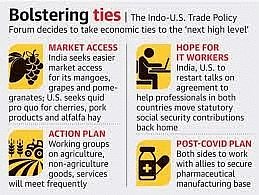
Why in News?
Recently, the Union Minister of Commerce and Industry of India and the US Trade Representative Ambassador co-chaired the 13th Ministerial-level meeting of India – US Trade Policy Forum (TPF) in Washington D.C.
What is the India-US TPF?
- About:
- The India-US TPF aims to activate its working groups in the fields of agriculture, non-agriculture goods, services, investment, and intellectual property to meet frequently and address issues of mutual concern in a mutually beneficial manner.
- The idea is to deliver tangible benefits to both countries by resolving outstanding market access issues.
- Highlights of the Meeting:
- While the two sides appreciated the rise in bilateral trade in goods and services (which reached ~160 billion USD in 2021), they also recognised that for economies of their size, significant potential still remains unfulfilled.
- The US welcomed India’s participation in the Indo-Pacific Economic Framework for Prosperity (IPEF).
- Both the countries have like-minded views about the efficiency of IPEF for continued growth, peace, and prosperity in the Indo-Pacific region.
- The Ministers welcomed the finalization of the Turtle Excluder Device (TED) design with the technical support of the National Oceanic and Atmospheric Administration (NOAA).
- The TED will help in minimizing the impact of fishing on sea-turtle populations.
- A new TPF Working Group on Resilient Trade was launched to help the officials deepen bilateral dialogue on a range of issues. Till the next TPF Ministerial meeting, it will focus on:
- Trade facilitation
- Promotion of labour rights and workforce development
- Circular economy; role of trade in environment protection
How are India’s Trade Ties with the US?
- India-US bilateral partnership today encompasses a whole host of issues including the response to Covid-19, economic recovery post-pandemic, the climate crisis and sustainable development, critical and emerging technologies, supply chain resilience, education, the diaspora, and defence and security.
- The US is India’s largest trading partner and most important export market. It is one of the few countries with which India has a trade surplus. In 2021-22, India had a trade surplus of USD 32.8 billion with the US.
- Although India and the US have quite contradictory responses towards the Russia-Ukraine crisis, the two have underscored their commitment to continue to build on the momentum of recent years and not lose sight of the larger strategic picture.
|
88 videos|123 docs
|
FAQs on International Relations: January 2023 UPSC Current Affairs - UPSC Mains: International Relations
| 1. What is the significance of the Indian Diaspora? |  |
| 2. What are the key aspects of India-Sri Lanka relations? |  |
| 3. What is the significance of the Indus Water Treaty, 1960? |  |
| 4. How does China's Dam Diplomacy impact international relations? |  |
| 5. What is the objective of the India-Oman Strategic Dialogue? |  |















